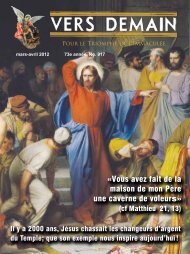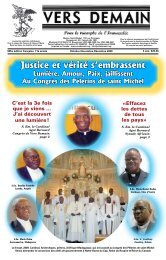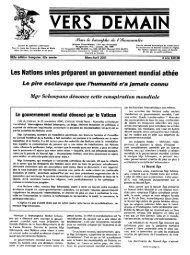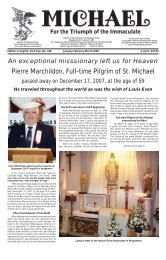For the Triumph of the Immaculate
For the Triumph of the Immaculate
For the Triumph of the Immaculate
You also want an ePaper? Increase the reach of your titles
YUMPU automatically turns print PDFs into web optimized ePapers that Google loves.
u A Constituent Assembly opened in 1917 to give <strong>the</strong><br />
country a new constitution. It was evidently drawn up in<br />
<strong>the</strong> revolutionary spirit <strong>of</strong> <strong>the</strong> hour. In <strong>the</strong> assembly debates,<br />
<strong>the</strong> clergy was called abject, guardians <strong>of</strong> ignorance,<br />
corruptor <strong>of</strong> morals, etc.<br />
One <strong>of</strong> <strong>the</strong> constituents approved that churches be<br />
burned, sanctuaries confiscated and even that a few<br />
monks be hung. Ano<strong>the</strong>r added: “If <strong>the</strong> ropes to hang <strong>the</strong><br />
tyrants are lacking, we will braid some out <strong>of</strong> <strong>the</strong> guts <strong>of</strong><br />
<strong>the</strong> priests.”<br />
The new constitution resumed and intensified <strong>the</strong><br />
non-religious clauses <strong>of</strong> <strong>the</strong> preceding ones which had<br />
not been strictly applied: compulsory lay education for all<br />
and interdiction <strong>of</strong> cults outside <strong>of</strong> sanctuaries. It forbade<br />
religious vows and communities. It deprived Mexican<br />
citizenship to whoever did not accept this constitution.<br />
Fa<strong>the</strong>r Ledit remarks that <strong>the</strong> Mexican constitution <strong>of</strong><br />
1917 inspired <strong>the</strong> writers <strong>of</strong> <strong>the</strong> soviet constitution <strong>the</strong> following<br />
year in Russia. This meant that Lenin’s Bolshevik<br />
clan, while waiting for a chance to throw itself upon Russia,<br />
a Russia sinking fast in military defeat and interior<br />
collapse, were keeping abreast <strong>of</strong><br />
what some comrades <strong>of</strong> <strong>the</strong> same<br />
type <strong>of</strong> demonism were accomplishing<br />
in Mexico.<br />
In 1920, a coup d’etat occurred:<br />
General Alvaro Obregon had President<br />
Carranza assassinated and<br />
took his place. It was not <strong>the</strong> end<br />
<strong>of</strong> <strong>the</strong> persecution, quite <strong>the</strong> opposite.<br />
Obregon, an impious man<br />
without scruples, had already distinguished<br />
himself in that regard.<br />
In 1912, he had desecrated a ca- Alvaro Obregon<br />
<strong>the</strong>dral (in Guadalupe) using it as<br />
quarters for his troops. As mayor <strong>of</strong> <strong>the</strong> city <strong>of</strong> Mexico in<br />
1916, he had assembled all <strong>the</strong> priests, declared <strong>the</strong>m<br />
prisoners and subjected <strong>the</strong>m to horrible treatment.<br />
After becoming president <strong>of</strong> all Mexico, he governed<br />
by applying <strong>the</strong> persecution clauses <strong>of</strong> <strong>the</strong> new constitution<br />
with vigor. The red flag was raised on <strong>the</strong> steeple<br />
<strong>of</strong> <strong>the</strong> ca<strong>the</strong>dral <strong>of</strong> Morelia; an image <strong>of</strong> Our Lady was<br />
slashed in <strong>the</strong> interior <strong>of</strong> a church that was ransacked,<br />
while <strong>the</strong> police frightened away <strong>the</strong> Catholics who wanted<br />
to hold a ceremony <strong>of</strong> reparation by firing gun shots in<br />
<strong>the</strong> air. The bishop’s palaces <strong>of</strong> Guadalupe and Mexico<br />
were bombed.<br />
The Catholics were suffering because <strong>of</strong> this persecution<br />
against <strong>the</strong>ir priests and <strong>the</strong> desecration <strong>of</strong> <strong>the</strong><br />
sanctuaries.<br />
There is, however, one sanctuary that <strong>the</strong> government<br />
did not dare touch, a church which it did not attempt to<br />
close: <strong>the</strong> basilica <strong>of</strong> <strong>the</strong> Holy Virgin <strong>of</strong> Guadalupe. The<br />
government was aware that if it touched <strong>the</strong> basilica, <strong>the</strong><br />
furor <strong>of</strong> <strong>the</strong> population would flare up, defying <strong>the</strong> police<br />
and all <strong>of</strong> <strong>the</strong>ir strength. The people would defend <strong>the</strong><br />
Madonna, allowing <strong>the</strong>mselves to be massacred ra<strong>the</strong>r<br />
than to surrender.<br />
It was a great thorn in <strong>the</strong> side <strong>of</strong> Masonry and <strong>of</strong><br />
<strong>the</strong>ir man in <strong>the</strong> presidency. In all evidence, <strong>the</strong> devotion<br />
<strong>of</strong> <strong>the</strong> population for this splendid and rich basilica was<br />
hanging on <strong>the</strong> presence <strong>of</strong> <strong>the</strong> miraculous picture, a gift<br />
from <strong>the</strong> Virgin Mary herself. Its preservation throughout<br />
<strong>the</strong>se nearly four centuries was in itself a miracle.<br />
The crowds continued to flow to <strong>the</strong> national sanctuary,<br />
finding at <strong>the</strong> feet <strong>of</strong> <strong>the</strong>ir Madonna, a source <strong>of</strong> hope in<br />
<strong>the</strong>se years where hell seemed to triumph in <strong>the</strong>ir beloved<br />
country.<br />
The Masons did not cease to suggest to <strong>the</strong> persecutors:<br />
“Get <strong>the</strong> venerated image out <strong>of</strong> <strong>the</strong> basilica and<br />
you will soon see <strong>the</strong> fervour <strong>of</strong> <strong>the</strong> population for this<br />
sanctuary fail; you will <strong>the</strong>n be able to confiscate it with<br />
its precious treasures.”<br />
Easily said but how do you take an image out <strong>of</strong> a<br />
busy church, an image that weighs close to a ton, due to<br />
<strong>the</strong> rich frame <strong>of</strong> pure gold?<br />
An anarchist named Luciano Perez was appointed<br />
to undertake <strong>the</strong> task. He thought it would be sufficient<br />
to plant a time bomb in <strong>the</strong> centre <strong>of</strong> a huge bouquet<br />
<strong>of</strong> flowers and deposit <strong>the</strong> bouquet in a good place, destroying<br />
<strong>the</strong> picture forever without taking it out <strong>of</strong> <strong>the</strong><br />
basilica. It would be a total victory!<br />
The anarchist put his plan into execution on <strong>the</strong><br />
14 th (or 24 th ) <strong>of</strong> November, 1921. As <strong>the</strong> faithful always<br />
brought an abundance <strong>of</strong> bouquets, <strong>of</strong>ten very large<br />
ones, to Our Lady, it was not hard to place <strong>the</strong> bouquet<br />
with <strong>the</strong> bomb close to <strong>the</strong> frame. The explosion took<br />
place at <strong>the</strong> minute indicated: a tremendous explosion<br />
drew a crowd <strong>of</strong> anxious Catholics towards <strong>the</strong> basilica.<br />
What did <strong>the</strong>y see as <strong>the</strong>y entered? Fragments <strong>of</strong><br />
broken glass were scattered on <strong>the</strong> floor; pieces <strong>of</strong> <strong>the</strong><br />
marble altar sown in all directions; <strong>the</strong> heavy crucifix<br />
surmounting <strong>the</strong> altar was lying, twisted, amongst o<strong>the</strong>r<br />
debris. But raising <strong>the</strong>ir eyes towards <strong>the</strong> beloved and<br />
venerated picture, <strong>the</strong>y saw it in its ordinary place and<br />
examining it closer, observed it had suffered no harm.<br />
There was not even a crack in <strong>the</strong> glass <strong>of</strong> <strong>the</strong> frame.<br />
The sorrow which had gripped <strong>the</strong> hearts <strong>of</strong> <strong>the</strong><br />
people at <strong>the</strong> sight <strong>of</strong> <strong>the</strong> damage was forgotten. Relief<br />
prevailed and was expressed<br />
in sincere prayers <strong>of</strong> gratitude. The<br />
material havoc in <strong>the</strong> basilica could<br />
be repaired but <strong>the</strong> destruction<br />
<strong>of</strong> <strong>the</strong> celestial image, which was<br />
beyond all human achievement,<br />
would have been irreparable.<br />
Plutarco Elias Calles<br />
Hell, which hoped to triumph<br />
over <strong>the</strong> devotion <strong>of</strong> <strong>the</strong> Mexicans<br />
for <strong>the</strong>ir Virgin <strong>of</strong> Guadalupe,<br />
served only to add a new miracle<br />
to <strong>the</strong> history <strong>of</strong> <strong>the</strong> marvellous picture.<br />
Even to martyrdom<br />
In this same month <strong>of</strong> November 1921, <strong>the</strong> presidency<br />
passed into <strong>the</strong> hands <strong>of</strong> Plutarco Elias Calles, who<br />
28 MICHAEL August/September 2011 www.michaeljournal.org<br />
had been designated by Obregon. The name <strong>of</strong> Calles<br />
will remain in <strong>the</strong> religious history <strong>of</strong> Mexico, spurned as<br />
that <strong>of</strong> Nero or Diocletian in <strong>the</strong> history <strong>of</strong> <strong>the</strong> Church<br />
under <strong>the</strong> Roman emperors.<br />
Born <strong>of</strong> a Jewish fa<strong>the</strong>r and a Mexican mo<strong>the</strong>r, Calles<br />
had been a school teacher. He had also participated in<br />
<strong>the</strong> persecution <strong>of</strong> priests under <strong>the</strong> presidency <strong>of</strong> Obregon.<br />
But he went much fur<strong>the</strong>r than his predecessor.<br />
He had sworn to destroy <strong>the</strong> Catholic Church in Mexico.<br />
He put bishops in prison, uttered insults against <strong>the</strong><br />
Pope and declared himself <strong>the</strong> personal enemy <strong>of</strong> Christ.<br />
“The Church has only one thing to do: disappear…<br />
We must uproot from Mexican soil all outworn religious<br />
ideas… We must undertake <strong>the</strong> terrible struggle against<br />
<strong>the</strong> past, against all <strong>the</strong> things which we must cause to<br />
disappear forever from <strong>the</strong> surface <strong>of</strong> <strong>the</strong> earth… The<br />
government is determined to execute its program without<br />
taking <strong>the</strong> slightest notice <strong>of</strong> <strong>the</strong> caretaker’s wincing<br />
or <strong>the</strong> protests <strong>of</strong> <strong>the</strong> lazy monks. Three times in my life<br />
I have met Christ on my path and three times I insulted<br />
Him.”<br />
The implementation <strong>of</strong> laws <strong>of</strong> June 24, 1926 added<br />
even more severe interdictions to anti-religious laws<br />
that had already been promulgated and punished <strong>the</strong><br />
infractions even more seriously. The religious cult came<br />
to be forbidden not only in sanctuaries but even in private<br />
homes. The various states <strong>of</strong> Mexico had to set a<br />
limit to <strong>the</strong> number <strong>of</strong> priests allowed, according to <strong>the</strong><br />
population. In certain areas, not more than one priest<br />
was allowed per 3,000 residents; elsewhere only one<br />
per 5,000; still elsewhere only one per 30,000 or even<br />
50,000! Holy water was forbidden. Images or statues<br />
had to be placed high enough or enclosed in nooks, so<br />
<strong>the</strong> faithful could not kiss <strong>the</strong>m and many o<strong>the</strong>r absurd<br />
regulations. A bishop from Tabasco received<br />
<strong>the</strong> order to marry or to leave <strong>the</strong><br />
country; he left.<br />
Because <strong>of</strong> <strong>the</strong> impossibility<br />
<strong>of</strong> exercising <strong>the</strong>ir ministry, <strong>the</strong><br />
priests received <strong>the</strong> order from<br />
<strong>the</strong>ir bishops, approved by Pope<br />
Pius XI, to suspend <strong>the</strong> exercise<br />
<strong>of</strong> <strong>the</strong> cult, beginning from July<br />
31, 1926. The faithful rushed to<br />
<strong>the</strong> churches to receive <strong>the</strong> sacraments<br />
<strong>of</strong> Penance and <strong>the</strong> Eucharist<br />
for <strong>the</strong> last time. Churches<br />
were draped with black as a sign<br />
<strong>of</strong> mourning. The tabernacles<br />
were emptied and <strong>the</strong> doors remained<br />
open.<br />
Viva Cristo Rey!<br />
Long Live Christ <strong>the</strong> King!<br />
Lay people organized <strong>the</strong>mselves to continue certain<br />
religious practices in <strong>the</strong> churches without a priest:<br />
prayers, hymns, rosaries, pious readings, and catechism.<br />
The priests who continued <strong>the</strong>ir ministry in hiding did<br />
so at <strong>the</strong>ir own risk. To be caught would mean prison<br />
or even death. In Mexico, 10,000 police agents traveled<br />
through <strong>the</strong> streets hunting recalcitrant priests.<br />
By November 1, 1926, Calles was boasting before<br />
Congress <strong>of</strong> having already closed 120 colleges and<br />
42 Catholic churches, filling prisons with priests caught<br />
celebrating Mass, and <strong>of</strong> having more than 500 priests<br />
killed.<br />
It was an era in which <strong>the</strong> Church in Mexico had to<br />
go underground, martyrs were numerous. The bishops,<br />
apart from a few who were able to hide, had to flee or<br />
were deported.<br />
Faced with this satanic outburst, Pope Pius XI was<br />
consoled to learn about <strong>the</strong> heroic fidelity <strong>of</strong> thousands<br />
<strong>of</strong> Mexican Catholics, who were made to choose between<br />
apostasy and cruel chastisements, <strong>of</strong>ten even put<br />
to death for <strong>the</strong>ir faith. The Pope wrote on November 18,<br />
1926:<br />
“It is impossible for us to delve into individual cases.<br />
We insist in letting you know one thing, <strong>the</strong> members <strong>of</strong><br />
Catholic associations are so unafraid <strong>of</strong> suffering, that<br />
instead <strong>of</strong> fleeing, <strong>the</strong>y seek danger and rejoice when<br />
<strong>the</strong>y have to suffer ill treatments on <strong>the</strong> part <strong>of</strong> <strong>the</strong>ir adversaries.<br />
It is a magnificent spectacle that is given to <strong>the</strong><br />
world, to angels and men! These are facts that are worthy<br />
<strong>of</strong> eternal praise. Numerous are <strong>the</strong> Catholic leaders,<br />
<strong>the</strong> women and young people who were arrested and<br />
dragged by soldiers through streets, shut up in filthy prisons,<br />
severely punished and chastised.<br />
Bl. Fr. Miguel Pro<br />
“Fur<strong>the</strong>rmore, some <strong>of</strong> <strong>the</strong>se<br />
young people and adolescents, and<br />
tears come to our eyes as we report<br />
this, voluntarily met death with<br />
<strong>the</strong>ir rosary in hand, <strong>the</strong> invocation<br />
<strong>of</strong> Christ <strong>the</strong> King on <strong>the</strong>ir lips. To our<br />
virgins enclosed in prisons, <strong>the</strong> most<br />
indignant outrages were done, and<br />
this was made known in order to intimidate<br />
o<strong>the</strong>rs and make <strong>the</strong>m fail in<br />
<strong>the</strong>ir duty…”<br />
One <strong>of</strong> <strong>the</strong> most famous martyrs<br />
was Fa<strong>the</strong>r Miguel Pro, a Jesuit<br />
whose cause was introduced in Rome<br />
to <strong>the</strong> Sacred Congregation <strong>of</strong> Rites in<br />
1952. (Editor’s note: Fr. Pro was de- u<br />
Prayer Execution Death Funeral











